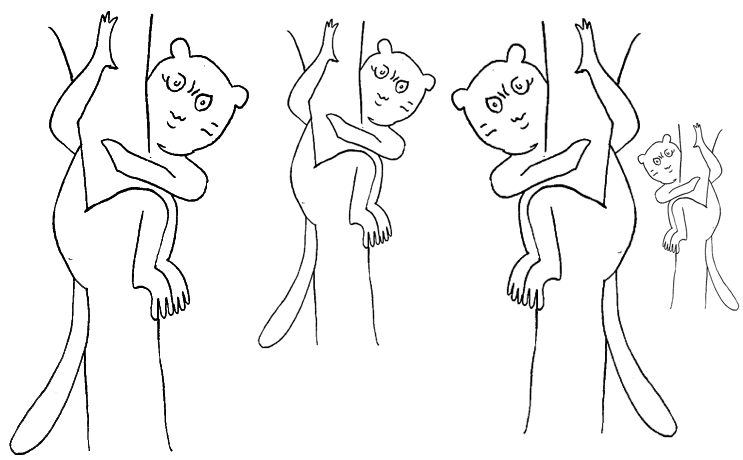
複数性の人類学について考える
What is the Anthrolopogy of Multiplicity?

★ 複数性・複数化の人類学(anthropology of multiplicity)で、われわれはなにを考えないとならないのか?
1)
オルターナティブとしての「複数性の人類学」を想定するなら、その否定である「単数性の人類学」が先行して存在しなければならない
2) 「単数性の人類学」なるものはなにか?
| AI の Monica に質問する→ |
複数性・複数化の人類学でどのような研究テーマが考えられますか? |
| 複数性・複数化の人類学において考えられる研究テーマは多岐にわたりま
す。以下にいくつかの例を挙げます。 |
|
| 1. アイデンティティと複数性 |
テーマ: 多文化社会におけるアイデンティティの形成 内容: 人々がどのように複数の文化的背景を持ち、それが彼らの自己認識にどのように影響するかを探る。 |
| 2. 社会的ネットワークと関係性 |
テーマ: 複数の社会的ネットワークの相互作用 内容: 友人関係や家族関係がどのように重なり合い、個人の社会的地位に影響を与えるかを分析。 |
| 3. 言語とコミュニケーション |
テーマ: 複数言語使用の社会的意味 内容: バイリンガルやマルチリンガルのコミュニティにおける言語の選択とその社会的・文化的影響を研究。 |
| 4. 環境と持続可能性 |
テーマ: 複数の生態系と人間の相互作用 内容: 異なる文化がどのように環境を認識し、持続可能な生活様式を形成しているかを探る。 |
| 5. グローバリゼーションとローカル文化 |
テーマ: グローバルな影響とローカルな反応 内容: グローバル化が地域文化に与える影響と、その中での複数の文化の共存を分析。 |
| 6. 性とジェンダー |
テーマ: 複数のジェンダーアイデンティティの理解 内容: ジェンダーの多様性がどのように社会的な役割や期待に影響を与えるかを探求。 |
| 7. 移民と流動性 |
テーマ: 移民の経験と複数性 内容: 移民が新しい文化に適応する過程での複数のアイデンティティの形成を研究。 |
| これらのテーマは、複数性・複数化の観点から人類社会の多様性を理解するための重要な視点を提供します。 |
☆ わたしたち、一人ひとりは、個性を持った個人なのか?それとも、なにかに属するメンバーにすぎないのか?
| おまえは誰なのか? |
おまえはどこに帰属するのか?(アイデンティティの同一性[同語反復]) |
| 君のIDを知りたい |
そのIDには国籍の表記がないぞ? |
| 不可分性、個別性、同一性、継続性 |
延長にある個人、集合的特徴、「人種」グループ、非同一性、分裂性、非
一貫性 |
| American Kinship is the first
attempt to deal systematically with kinship
as a system of symbols and meanings, and not simply as a network of
functionally interrelated familial roles. Schneider argues that the
study of a highly differentiated society such as our own may be more
revealing of the nature of kinship than the study of anthropologically
more familiar, but less differentiated societies. He goes to the heart
of the ideology of relations among relatives in America by locating the
underlying features of the definition of kinship—nature vs. law,
substance vs. code. One of the most significant features of American
Kinship, then, is the explicit development of a theory of culture on
which the analysis is based, a theory that has since proved valuable in
the analysis of other cultures. For this Phoenix edition, Schneider has
written a substantial new chapter, responding to his critics and
recounting the charges in his thought since the book was first
published in 1968. - American kinship : a cultural account / David M. Schneider, University of Chicago Press , 1980 |
アメリカの親族関係は、単に機能的に相互に関連する家族的役割のネット
ワークとしてではなく、象徴と意味のシステムとして親族関係を体系的に扱った最初の試みである。シュナイダーは、我々のような高度に分化した社会を研究す
る方が、人類学的に馴染み深いがそれほど分化していない社会を研究するよりも、親族関係の本質をより明らかにできるかもしれないと主張している。彼は、親
族関係の定義の根底にある特徴——自然〈対〉法、実質〈対〉規範(substance
vs.
code)——を突き止めることで、アメリカにおける親族関係のイデオロギーの核心に迫っている。『アメリカン・キンシップ』の最も重要な
特徴のひとつ
は、分析の基礎となる文化論を明示的に展開したことである。このフェニックス版のために、シュナイダーは批評家への反論と、1968年の初版刊行以来の彼
の思想に対する批判を詳述する、大幅な新章を書き下ろした。 |
| While at Chicago, Schneider
was director of the Kinship Project, a study supported by the National
Science Foundation that looked at how middle-class families in the
United States and Great Britain respond to their kinship relations. His
findings challenged the common-sense assumption that kinship in
Anglo-American cultures is primarily about recognizing biological
relatedness. While a rhetoric of "blood" ties is an important
conceptual structuring device in US and British kinship systems,
cultural and social considerations are more important. The discoveries
he demonstrated through a series of books, most famously American
Kinship: a Cultural Account, revolutionized and revitalized the study
of kinship within anthropology, on the one hand, and contributed to the
theoretical basis of feminist anthropology, gender studies, and lesbian
and gay studies, on the other. |
シカゴ大学在学中、シュナイダーは、国民科学財団の支援を受け、米国と
英国の中流家庭が親族関係にどのように対応しているかを調査する研究「親族関係プロジェクト」のディレクターを務めた。彼の発見は、英米文化における親族
関係は主に生物学的な血縁関係を認識するものであるという常識的な仮定を覆すものであった。「血縁」というレトリックは、米英の親族制度における重要な概
念的構造化装置ではあるが、文化的・社会的配慮の方がより重要なのである。シュナイダーが一連の著書、とりわけ有名な『American
Kinship: a Cultural
Account(アメリカの親族関係:文化的説明)』を通じて示した発見は、一方では人類学における親族関係の研究に革命をもたらし、活性化させ、他方で
はフェミニスト人類学、ジェンダー研究、レズビアン・ゲイ研究の理論的基礎に貢献した。 |
| The structure of living
organisms is better able to reflect complex social
forms than doorposts and lintels. So we find that the rituals of
sacrifice
specify what kind of animal shall be used, young or old, male, female
or
neutered, and that these rules signify various aspects of the situation
which
calls for sacrifice. The way the animal is to be slaughtered is also
laid
down. The Dinka cut the beast longitudinally through the sexual organs
if
the sacrifice is intended to undo an incest; in half across the middle
for
celebrating a truce; they suffocate it for some occasions and trample
it to
death for others. Even more direct is the symbolism worked upon the
human body. The body is a model which can stand for any bounded
system. Its boundaries can represent any boundaries which are
threatened
or precarious. The body is a complex structure. The functions of its
different parts and their relation afford a source of symbols for other
complex structures. We cannot possibly interpret rituals concerning
excreta, breast milk, saliva and the rest unless we are prepared to see
in the
body a symbol of society, and to see the powers and dangers credited to
social structure reproduced in small on the human body. M. Douglas, Purity and Danger(1966)pp.115-116 |
生物の構造は、門柱やまぐさよりも複雑な社会形態を反映しやすい。その
ため、供犠の儀礼では、どのような動物を使うか、若いものか老いたものか、雄か雌か去勢されたものか、が指定され、これらの規則が生贄を必要とする状況の
さまざまな側面を意味することがわかる。動物の屠殺方法も定められている。ディンカ族は、近親相姦を取り消すための生け贄であれば性器を縦に切り、停戦を
祝うための生け贄であれば真ん中を真っ二つに切り、窒息死させる場合もあれば踏み殺す場合もある。さらに直接的なのは、人体に対する象徴主義である。身体
は、あらゆる境界を持つシステムを象徴するモデルである。その境界は、脅かされたり、不安定になったりするあらゆる境界を表すことができる。身体は複雑な
構造をしている。その異なる部分の機能とその関係は、他の複雑な構造を象徴する源となる。排泄物、母乳、唾液、その他に関する儀式を解釈するためには、身
体の中に社会の象徴を見いだし、社会構造が持つ力と危険性が人体上に小さく再現されていると見る覚悟がなければ、到底無理な話である。 |
| Second, all margins are
dangerous. If they are pulled this way or that
the shape of fundamental experience is altered. Any structure of ideas
is
vulnerable at its margins. We should expect the orifices of the body to
symbolise its specially vulnerable points. Matter issuing from them is
marginal stuff of the most obvious kind. Spittle, blood, milk, urine,
faeces
or tears by simply issuing forth have traversed the boundary of the
body.
So also have bodily parings, skin, nail, hair clippings and sweat. The
mistake is to treat bodily margins in isolation from all other margins.
There is no reason to assume any primacy for the individual’s attitude
to
his own bodily and emotional experience, any more than for his cultural
and social experience. This is the clue which explains the unevenness
with
which different aspects of the body are treated in the rituals of the
world.
In some, menstrual pollution is feared as a lethal danger; in others
not at
all (see Chapter 9 ). In some, death pollution is a daily
preoccupation; in
others not at all. In some, excreta is dangerous, in others it is only
a joke.
In India cooked food and saliva are pollution-prone, but Bushmen
collect
melon seeds from their mouths for later roasting and eating (Marshall
Thomas, p. 44). M. Douglas, Purity and Danger(1966)p.122 |
第二に、すべての境界は危険である。余白があっちに引っ張られたりこっ
ちに引っ張られたりすると、基本的な経験の形が変わってしまう。あらゆる観念の構造は、その境界において脆弱である。身体の開口部は、その特別に脆弱な点
を象徴していると考えるべきだ。そこから排出される物質は、最も明白な種類の境界物質である。唾液、血液、ミルク、尿、糞便、涙は、ただ出るだけで、身体
の境界を越えている。また、身体の一部、皮膚、爪、髪、汗などもそうである。間違いとは、身体の境界を他のすべての境界から切り離して扱うことである。個
人の身体的、感情的経験に対する態度を、文化的、社会的経験以上に優先させる理由はない。これが、世界の儀式において身体の異なる側面がどのように扱われ
ているかを説明する手がかりとなる。あるところでは、月経の汚染は致命的な危険として恐れられているが、別のところではまったく恐れられていない(第9章
参照)。死の汚染は日常的な関心事であるところもあれば、まったくそうでないところもある。排泄物が危険な人もいれば、冗談にしかならない人もいる。イン
ドでは調理済みの食べ物や唾液は汚染されやすいが、ブッシュマンは後で焼いて食べるためにメロンの種を口から採取する(マーシャル・トーマス、44ペー
ジ)。 |
| It is worth using the Indian
example to ask why saliva and genital
excretions are more pollution-worthy than tears. If I can fervently
drink
his tears, wrote Jean Genêt, why not the so limpid drop on the end of
his
nose? To this we can reply: first that nasal secretions are not so
limpid as
tears. They are more like treacle than water. When a thick rheum oozes
from the eye it is no more apt for poetry than nasal rheum. But
admittedly
clear, fast-running tears are the stuff of romantic poetry: they do not
defile.
This is partly because tears are naturally pre-empted by the symbolism
of
washing. Tears are like rivers of moving water. They purify, cleanse,
bathe
the eyes, so how can they pollute? But more significantly tears are not
related to the bodily functions of digestion or procreation. Therefore
their
scope for symbolising social relations and social processes is
narrower.
This is evident when we reflect on caste structure. Since place in the
hierarchy of purity is biologically transmitted, sexual behaviour is
important for preserving the purity of caste. For this reason, in
higher
castes, boundary pollution focusses particularly on sexuality. The
caste
membership of an individual is determined by his mother, for though she
may have married into a higher caste, her children take their caste
from
her. Therefore women are the gates of entry to the caste. Female purity
is
carefully guarded and a woman who is known to have had sexual
intercourse with a man of lower caste is brutally punished. Male sexual
purity does not carry this responsibility. Hence male promiscuity is a
lighter matter. A mere ritual bath is enough to cleanse a man from
sexual
contact with a low-caste woman. But his sexuality does not entirely
escape the burden of worry which boundary pollution attaches to the
body.
According to Hindu belief a sacred quality inheres in semen, which
should not be wasted. M. Douglas, Purity and Danger(1966)pp.125-126 |
イ
ンドの事例を使って、なぜ唾液や性器の排泄物が涙よりも公害に値するのかを問う価値はある。もし私が彼の涙を熱心に飲むことができるなら、なぜ彼の鼻の先
にある清冽な雫は飲めないのだろうか?第一に、鼻汁は涙ほど清冽ではない。鼻汁は水というより、宝石のようなものだ。濃いリュームが目からにじみ出ると
き、それは鼻リュームほど詩には適さない。しかし、清らかで流れるような涙は、ロマンチックな詩の素材であることは間違いない。その理由のひとつは、涙は
洗うという象徴によって自然に先取りされるからである。涙は動く水の川のようなものだ。涙は目を浄化し、清め、浴びるのだ。さらに重要なことは、涙は消化
や子孫繁栄といった身体機能とは無関係だということだ。したがって、社会関係や社会的プロセスを象徴する範囲は狭い。このことは、カースト構造を考えれば
明らかだ。純潔の階層における地位は生物学的に伝達されるため、性的行動はカーストの純潔を守るために重要である。このため、上位カーストでは、境界汚染
は特にセクシュアリティに集中する。なぜなら、母親がより高いカーストに嫁いだとしても、その子供は母親からカーストを受け継ぐからである。したがって、
女性はカーストへの入り口である。女性の純潔は注意深く守られ、下位カーストの男性と性交渉を持ったと知られた女性は残酷に罰せられる。男性の性的純潔に
はこのような責任はない。したがって、男性の乱交は軽い問題である。低カーストの女性との性的接触から男性を清めるには、単なる儀式的な入浴で十分であ
る。しかし、彼の性欲は、境界の汚染が身体に与える心配の重荷から完全に逃れられるわけではない。ヒンドゥー教の信仰によれば、精液には神聖な性質が宿っ
ており、無駄にしてはならない。 |
| A. Mol, Body Multiple(2002) |
モル『多としての身体 : 医療実践における存在論』 |
| 実名のアカウント(リアルな私はヴァーチャルな存在ではない) |
ア
バター(ネットワークのなかのわたし)/ミーム(自己という摸倣子)、自己の複数化 |
| 西洋個人主義(→個人主義) |
|
| 個の確立、人格の確立、自己意識、アイデンティティ、誠実 |
夢や憑依もリアリティのレパートリーにある、人格の多元性、なりすま し、詐欺 |
| 自己証明(パスワードや生体認証、あるいはIDカード)、バイオデータ |
複数のアカウント、匿名化、自己あるいは他者を偽装する |
| 自己保存、利己性 |
自己犠牲、利他性、 |
| 人格の統一性、オーティズム |
多重人格、乖離状態、ドッペルゲンガー、インナーチャイルド |
| 証言の一貫性、ひとつの視点 |
証言の多元性、複数のバースペクティヴをもつ |
| バトラーは『自分自身についての説明を与える(Giving an
Account of Oneself,
2005)』において、主体自身の不透明性、言い換えれば自己認識の限界に基づく倫理学を展開している。主にテオドール・アドルノ、ミシェル・フー
コー、フリードリヒ・ニーチェ、ジャン・ラプランシュ、アドリアナ・カヴァレロ、エマニュエル・レヴィナスから借用し、バトラーは主体の形成に関する理論
を展開している。バトラーは、主体を社会的なもの——他者の共同体やその規範——との関係において理論化する。社会的なものは、主体が形成する条件そのも
のであり、主体が文法的な「私」として認識されるようになるための資源である(→「人類学における自己と他者」)。 |
|
| 「同一性の思考は、歴史上つねに、いっさいを飲み尽くすもの——死をも
たらすものであった」(アドルノ 1992:166) |
リ ンク
文 献
そ の他の情報
CC
Copyleft, CC, Mitzub'ixi Quq Chi'j, 1996-2099
☆
 ☆
☆